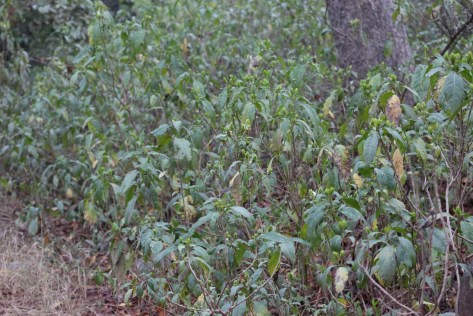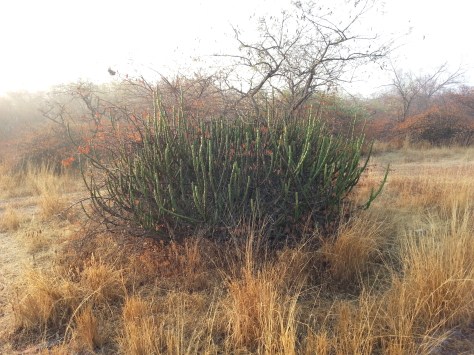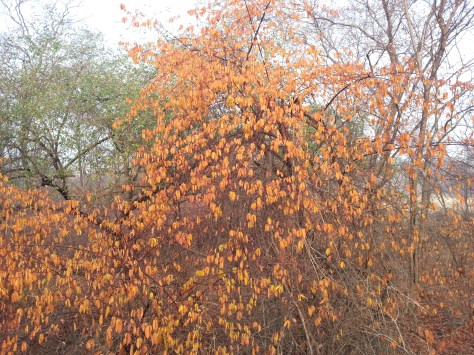Trip: Ranthambore National Park
Camp: Ranthambhore Regency
Dates: 23-26 Jan ‘15
Who: GiK, Drs R and M and kids V and P
We should have flown to Jaipur and driven from there to Sawai Madhopur (150 kms). Instead we flew to Delhi, reached there an hour later than scheduled, at about 9:30 PM, dealt with the pathetic airport taxi system to get to Hazrat Nizamuddin station, and took the 11:40 PM Haridwar-Mumbai Bandra Terminus SF Express that ended up leaving Delhi at 1:45 AM. We reached Sawai Madhopur at sometime past 6 AM, a full ninety minutes past schedule and rushed to catch the morning safari. And all this with two kids and a cold wave in attendance. Flying to Jaipur would have been the sensible thing to do, even if it meant some loss of daytime.
The zones
We spent four days in Ranthambore, doing seven safaris in all. Ranthambore has ten numbered tourist zones, with ten gypsies allowed into each zone at a time. On weekends, the FD allows a few more under pressure from VIPs. In fact the FD themselves possess safari-ready gypsies for ferrying their guests around. These gypsies have the triple advantages of no zone restrictions, no time restrictions and a ready information feed via radio.
Zones 1 to 5 are the sought-after ones, with zone 3 being the clear favourite at this time. It is evidently not easy to get the popular zones booked. Regency get an assortment of zones booked daily and ration them among their guests to ensure everyone gets a fair share of the more productive zones. And so we did three safaris in zone 3, two in zone 4 and one each in zones 2 and 6.
Entry to zones 2 and 3 is via the Jogi Mahal gate. The picturesque zone 3 route winds past the Padam talao (on the banks of which the famed Jogi Mahal is sited) and onto the vast Raj Bagh lake. The abandoned hunting lodge on the latter has produced some fine images of tigers on its balcony framed by its structure and shot from across the lake. Finding tigers in this structure is evidently a summer phenomenon.
Zone 2 is magnificent too, with the road winding by the towering Ranthambore fort and then past another long range of cliffs. However twice a month on chaturdashi days of the Hindu calendar, pilgrims troop through this zone barefoot to worship at a Ganesh temple somewhere. The resultant ruckus effectively puts paid to any decent sighting possibilities. That’s what happened to us on day 1 in the afternoon.
GiK and I thought zone 4 was the best of them all in terms of its beauty. At this time of year, it has several stunningly beautiful spots, especially large patches of bright, finely textured grass. A tiger on this grass in mellow morning light will make for a dream photograph. Zone 4 also has a large lake teeming with aquatic birds, muggers and sambar – Malik talao.
This zone is accessed via a gate placed to the left of the approach road some distance before the Jogi Mahal gate is reached.
The anicut in zone 4 in the morning mist:
In contrast with these three zones, zone 6 is a drab and dreary affair, with no impressive landscapes or features – just dusty tracks winding through unprepossessing, stunted jungle. To make matters worse, this zone is accessed after negotiating the sewer-lined, congested bazars of old Sawai Madhopur. If this route is bad in winter, I shudder to think what it’ll be in the heat of summer. But to be fair, we did sight a tiger in zone 6, and a magnificent male in his prime at that.
Tiger centricity
At the outset, our very competent naturalist Satish Upadyay suggested that we get the tiger sighting out of the way before turning our attention to birding. GiK, my kid P and I were in one Gypsy and we started with zone 3. We reached Rajbagh and struck luck. Three 10-month cubs gamboling in the grass, the litter of the tigress T-19 or Krishna. This tigress is Machli’s offspring and the reigning queen tigress of Ranthambore. We didn’t see the mother though, just the cubs. They were some 40-50 feet from the jeep, by the water and we watched them for twenty minutes or so before they headed back into taller khus grass where a sambar kill was hidden.
As often happens, this spectacular start was followed by muted follow-through, with plenty of alarm calls but no sightings fructifying until the evening of the next day. That was the afternoon safari of day 2, in zone 6. A passing Gypsy reported seeing a tiger cross a nallah and disappear into the jungle. Scouting around we finally came to a cluster of jeeps with the tiger barely visible some two hundred meters away. This was T-34 or Kumbha, a tiger with a colourful reputation for intimidating behavior. He was lying on his back with his paws in the air.
Ranthambore allows safaris in Gypsies and Canters. The latter contain five seats to a row and it mustn’t be great fun to be stuck in the middle. Anyway there were plenty of noisy tourists in attendance and the din disturbed the animal enough to make him roll over one side to the other occasionally and lift his head up to see what the racket was all about. This went on for about fifteen minutes after which he was disgusted enough to rise and stalk away. The horde then started up to chase him, but by the time the jam could be sorted out and the vehicles turned around, a good ten minutes was lost. Meanwhile the cat disappeared without a trace.
Satish had predicted a success rate of 30%. We did a little better than that, with three sightings in seven safaris. On day 3 in the evening safari, we had spent the evening chasing alarm calls in vain all over zone 4. Often being in the unenviable situation of having calls emanating from two different directions.
An interesting feature of tiger tracking in Ranthambore is that when alarm calls are heard, whether chital or langur, Satish listened to see if multiple individuals were calling. Calls by single individuals evidently lack credibility and were actually ignored a couple of times, even when persisting for a while. Satish also mentioned that while chital or sambar calls may sometimes mislead, the nilgai’s alarm call, if heard, is a certain indicator of the tiger’s presence.
Exit time was at 5:30 and we’d spent much of the evening rushing from one set of calls to another. While we were stopped in one of the meeting points for a quick bio break, a gypsy rolled in and the woman in it asked why all of us were hanging around there while there was a sighting in progress elsewhere. Satish and the driver jumped like they were bee-stung and we began a crazy, careening hurtle at mad speed towards the spot indicated. This was quite a distance away and we had just about half an hour to go before exit time, with the exit gate a long way off.
Reaching the place we found that it was hardly a kilometer’s distance from where we’d waited a while earlier listening to chital calls. Some jeeps had gone ahead from that point but had returned without having spotted the tiger. Given the late hour, all the vehicles there were FD Gypsies, with our Gypsy and a canter that arrived later being the only commercial tourist vehicles. The tiger was sprawled on the grass across a ravine amidst some very pretty scenery. This was T-6 or Romeo a fine six year old male. We had around five minutes to take a good look and finish clicking pictures before it was time to hurtle back towards the exit gate. The driver incidentally clocked 85 kmph on that crazy drive and we spent much of it in the air, holding on tight to keep us from bouncing right off the jeep. Admittedly illegal but incredible fun though.
Leopards are at least as numerous as tigers in Ranthambore but as is typical of tiger-infested areas, rarely show themselves.
Both chital and sambar were numerous and the long-drawn rutting calls of chital stags reverberated through the forests at this time of year, sometimes startling innocent tourists who mistook them for the agonized screams of some animal being done to death.
Upwardly mobile chital stag:
Sambar stags sparring:
Nilgai are also fairly numerous in places, and GiK and I got some pictures.
Nilgai doe and buck in the mist:
Nilgai buck:
We also saw the Chinkara or Indian Gazelle for the first time, a very satisfying experience. Mugger are commonly seen on all the lakes.
There were several palm squirrels in the forest. After a desultory glance at one of them, I concluded that they were of the three-striped variety. Dr. R later told me that we were probably looking at Five-striped palm squirrels. I resolved to look more carefully and get a picture if possible on the next outing, but this slipped my mind and I didn’t see any more squirrels.
Birding
Most remarkable are the Indian treepies. They are exceedingly common all through the forest, and are inured to tourists feeding them, although that is supposedly banned now. We did see some tourists feeding the birds at the rest points though. The birds however have lost their fear of people and freely perch on heads and hands. They are fearless enough to hop into the gypsies and onto the floor right around our feet, hunting for crumbs. Stop at any spot and in all likelihood, a couple materialized, heads cocked greedily, inspecting us closely for signs of anything edible.
Peafowl are numerous as you might expect, and the persistent, two-note calls of Grey francolins rent the air frequently.
Babblers, especially jungle babblers are numerous too and make it noisily evident. Large grey babblers are easily met with and I initially mistook them for jungle babblers until Dr. R pointed this out. Rose-ringed parakeets are another noisy, frequently encountered bird. We met spotted owlets around half a dozen times, so they are not uncommon here.
Long-tailed shrike:

Hoopoe on a Dhok tree:
In the waters of the lakes were Ruddy shelducks, Wooly-necked storks, Grey herons, Common snipes, egrets, cormorants, darters, White ibis, Openbill storks, River terns, dozens of Common moorhen, plenty of Black-winged stilts, more White-breasted waterhen than I’ve cumulatively seen so far and intrepid Red-wattled lapwings that stalked right up to the jeeps hunting for insects dislodged by the tyres.
Wooly-necked stork:
Black-winged stilt:
Black-capped night heron:
We noted that barbets were strangely absent, although Dr. R’s naturalist pointed out that Coppersmith barbets did occur and were heard in the summer. Junglefowl are conspicuously absent.
Indian Scops owl:
On the drive from Sawai Madhopur to Jaipur (we took the more sensible route on the way back), we saw Bank mynas for the first time whilst stopping for chai.
Crested serpent eagle:
Flora
The landscape of Ranthambore is dominated by the tiny-leaved Dhok tree (Anogeissus pendula). This species comprises a good seventy or eighty percent of the forest’s tree-count and is therefore ubiquitous. Next in terms of frequency are Babul or the Gum Arabic tree (Acacia nilotica) and the Flame of the forest (Butea monosperma).
Acacia nilotica:
Stunted Khair trees (Acacia catechu) are also frequently encountered.
On rocky slopes, the striking-looking Karaya Gum tree (Sterculia Urens) is commonly seen.
Several fine specimens of banyan (Ficus bengalensis) are found throughout the park including the iconic one draping the entrance a little before the Jogi Mahal gate. An exceptionally large specimen occurs near the Jogi Mahal, but is out of bounds for tourists.
Indian date palms (Phoenix sylvestris) are frequently met with. Tendu (Diospyros melanoxylon) is also encountered occasionally. Adusa (Adhatoda vasica) occurs in clumps in many places. The leaves, flowers and bark of this shrub find medicinal uses chiefly in the treatment of asthma.
Large clumps of the cactus-like Euphorbia plant are also seen.
A very common shrub in the Dhok forests is Grewia flavescens. At least that’s what I think it is. Our naturalist Satish identified the plant as Chameni in Hindi. I struggled to locate the binomial name and after considerable search, am leaning towards Grewia flavescens. This Grewia species is reputed to be a frequent associate of the Dhok and is supposedly commonly found in Ranthambore. The plant we saw is certainly found all over the place.
The lakesides are lined with the aromatic Khus grass (Vetivaria zizznioides). Large patches of striking red Water velvet (Azolla pinnata) were found on the surfaces of some lakes. This is a species of tiny-leaved aquatic fern.
Birds:
- Asian pied starling
- Ashy-crowned sparrowlark
- Bank myna
- Long-tailed shrike
- Black-capped night heron
- Black drongo
- Black-shouldered kite
- Black-tailed godwit
- Black-winged stilt
- Blue rock dove
- Bluethroat
- Brown rock chat
- Cinereous tit
- Common iora
- Common kingfisher
- Common moorhen
- Common snipe
- Crested serpent eagle
- Darter
- Eurasian thick-knee
- Greater cormorant
- Greater coucal
- Grey francolin
- Grey heron
- Grey wagtail
- Hoopoe
- Indian Scops owl
- Indian vulture
- Long-tailed shrike
- Indian treepie
- Jungle babbler
- Large egret
- Large grey babbler
- Lesser flameback
- Little brown dove
- Little green heron
- Magpie robin
- Oriental honey buzzard
- Osprey
- Painted stork
- Peafowl
- Painted spurfowl
- Pied kingfisher
- Plain prinia
- Red-breasted flycatcher
- Red-wattled lapwing
- River tern
- Rose-ringed parakeet
- Ruddy shelduck
- Spotted dove
- Stonechat
- White-belloed drongo
- White-breasted waterhen
- White-browed fantail
- White-browed wagtail
- White ibis
- White-throated kingfisher
- White wagtail
- Wooly-necked stork
- Yellow-footed green pigeon
Mammals:
- Chinkara
- Chital
- Common langur
- Nilgai
- Ruddy mongoose
- Sambar
- Tiger
Reptiles:
- Marsh crocodile
































Nicely written Badri with beautiful images.
P.s I think it’s a long-tailed shrike consifering the grey crown ,larger size and rufous rump
Thanks Ravi. You are right about the shrike. Corrected now.
Wow! Seems like a lovely trip and the pictures are beautiful. Esp the bird perched on the head.
Sent from my iPhone
>
Thank you Vandana. Yes, it was lovely in winter.
Badri,
Chanced upon your website while browsing for wildlife in India.Keep up the good work.Our family (My Son,Wife and me) are avid WIldlife enthusiasts and we have been visiting Masinakudi every year for 18 years.(And seen a Tiger just Once !!!!)
Would love to connect with you next time we are in India.
Being in the US does not give us too many options to visit Tiger Sanctuaries in MP/Rajasthan and Maharashtra 😦 as we visit friends and families in Chennai and Bangalore.
If you like books try Cheetal Walk and Whispers in the Jungle by ERC Davidar.They are worth a read.
Thank you for the kind words, Kumar. There are plenty of wildlife options not far from Bangalore. You should definitely give one of the Jungle Lodges properties a shot – Kabini, Bandipur, K Gudi or the River Tern Lodge – probably in that order of preference. Yes I’ve enjoyed Cheetal walk and WITW immensely and have been intending to do a review for a year now. Thank you for the excellent suggestion nonetheless.
Thanks Badri, Does Jungle Lodges have 3 night options ?Their website does not talk about it.
There is no 3-nights option in the sense of a discounted package I guess if that’s what you mean. You just have to book 3 regular nights. It has incidentally been raining cats in Kabini for the past few weeks I believe. Leopards and tigers both. You can give JLR a call. They’re usually happy to help. Very unlike the govt organization that they are.
wow – it must have been a great experience!! congratulations to the great photos!
Thank you Matthias. Yes, it was good fun.